Aswan West Bank
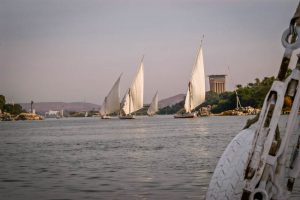
A later start today, with George (who is younger brother of our guide the previous day — he took over for her since we would be hiking/riding in the desert and she didn’t feel up to it). We started with a felucca ride around Elephantine Island and drifted along with the breeze on the Nile and enjoyed the view. Our felucca captain brewed tea for us as we cruised. While there are motor boats on the nile around Aswan, the sleek single-masted felucca are more than just tourist attractions; they are working boats for many people. After a tour around the island (and warnings not to drag our hands in the water) we made for a landing on the west bank. From the beach, we hiked up the hill to ride camels to St. Simeon monastery.
Camel Parking
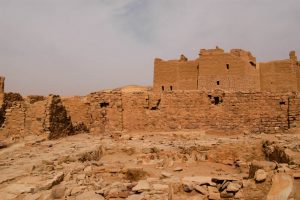
The monastery is really more of a fortress — high walls and tiny arrow slits, much more castle-like then a religious. The whole building is poorly preserved, but some of the iconic images painted in the monk’s cells are beautiful — very Byzantine — and the layout of the place is reminiscent of the abbeys and churches we saw in Scotland. It was interesting to see the parallels between the two structures.
As usual, Mark pointed out that It would be hard to attack..it’s uphill all the way and surrounded by rolling soft sand.
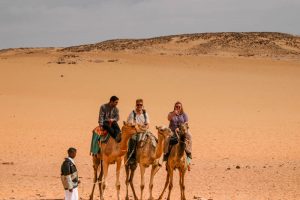
We hiked back to the camels and rode of into the desert. I know that we were heading directly towards the Nile, but within five minutes, all I could see was sand dunes in all directions and it all looked pretty much the same!! I can see how people would get lost out here for days. The dunes undulate a hundred feet or more — when you are on the top, you can see for miles…miles and miles of sand. Even in the direction of the river, I can’t see the tell-tale green swath by the water. The Nile runs between fairly steep cliffs and just disappears unless you are right on top of it.
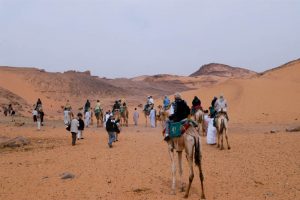
The camel herders walked along with the camels while we rode, usually hanging off the saddle straps to get pulled along. I’ve only walked a few hundred yards in the soft, shifting sand and it’s tiring. I can’t imagine making this trip a few times a day. The camels do ok, though. At least once, I got to jog off on my own, arms flapping and jouncing as the camel loped across the flats. Then, realizing that he’d left his compatriots behind, the camel would just stand there, waiting for the others. Nothing I could do would convince him to move.
After about forty-five minutes on camels, we arrived at the base of the Tombs of the Nobles in the hillside overlooking Aswan. Most of these tombs are very plain — just a few holes in the cliff walls — but a few have interesting paintings and later icons when they were used as churches and chapels. These are not the deep hole-tombs of the Valley of the Kings, but instead are large courtyards with multiple small chambers, quite shallow. It is very hot on the cliffs, and in a few places the hike is a bit iffy — showering rocks down the cliff side to the lower tombs. The highest tombs are the oldest, with Roman-age tombs down nearer the water and more likely to flood.
Cow’s Heads and Tea
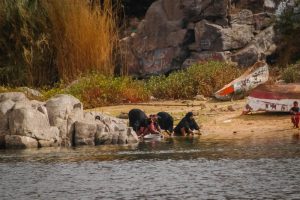
Back down to the camels (again!) to visit one of the Nubian homes in the area. Unlike Cairo, with its multistory apartments with many families inside, Nubian homes are usually single family, single story, and brightly colored. The houses are plastered with mud-plaster and painted and decorated both outside and in. The houses are like many in the desert — outside, a flat wall enclosed a courtyard with rooms surrounding it. It is cooler inside. There is electricity here, but we never did see a sign of running water.
The area is very very poor, but the family (only the women were there, preparing for the feast) still offered us tea and coffee and even hot soup and bread. It was Festival day, so a quick tour of the home revealed a dead cow head (source of the soup they served us) and bloody hand prints on most of the doors. Everyone was very nice, but it was a bit uncomfortable — they do not want to be a tourist attraction, but I’m sure the remuneration for taking in tourists helps and they were very hospitable. I made sure to poke my head into the “kitchen” and say thank you, it seemed to be appreciated.

We said goodbye to the camels and walked through the village to catch our ride back across the Nile. Along the way we stopped in a small bazaar and I got to hold a baby crocodile, about 18″ long — which promptly pooped on me. Feeling like we should buy something after all the trouble they went to, we bargained for a small alabaster vase.
A gaggle of young boys playing with balls and sticks in the street spotted gum in Mark’s backpack and mobbed him for it. We thought it was kind of funny, until a few days later I actually started a fight with a few sticks of gum….We watched the “top boy” divvy up the gum to the others and and then we headed back to the hotel to clean up. Considering that I’d had a camel blow snot on my leg, stepped in donkey poop, and had a small crocodile crap on my shoulder, I needed a shower!
More Sounds and Light
We met a two very nice gentlemen on the way to the Sound and Light show on Philae and they shared our boat. Our tour manager was apoplectic about it, but after a bit of an argument over price (LE20), we were ok with it. The boat was “ours” you see, as the tour manager pointed out. As long as the two extra guys paid for their seats and didn’t cheat the boatman, we didn’t care, and we enjoyed the company. They are both teachers in Cairo (one of English, the other history)
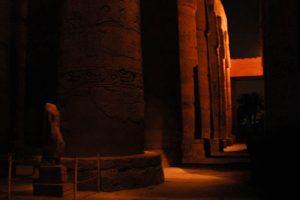
This sound and light show includes walking though the ruins before sitting down. It’s pretty cool, although not as splendiferous as Abu Simbel. Once again, the dialog is a bit cheesy, at least in English. But I guess you can’t beat it for a quick history of the place, and I have to admit that the carefully spotlighted temples are beautiful.
Our boat was the last back and our escort was a bit nervous (thought we’d been abducted or something!). The boat guy (a very stout older man) couldn’t get the motor started at first, but a bit of judicious kicking and rattling finally got it going. We road back in he dark, looking at the beautifully-lit temple as we circled the island.
An Egyptian ambulance was parked at the dock when we returned and Mark convinced our guide to ask them if he could look inside. (He’s an EMT and critical care nurse here in Colorado). He spent a few minutes asking questions and crawling around in the back of the rig, thanked everyone profusely, and then told me, quietly, in the car on the way back, “NEVER get in an accident here.” Apparently the contents of the ambulance were primitive, at best, and the nearest hospital was over an hour away. Ambulance service in Egypt is much like it was in the states a few decades ago — they don’t actually provide much medical care in the truck, so they drive like hell to get you to a hospital. That’s their primary purpose. They do the best they can, but they simply don’t have the resources. It was an interesting stop.
Vegetables of the Debbil
Afterwards, they dropped us off at Dokka, the new Nubian restaurant on the island. We had asked them to arrange dinner there for us, on the recommendation of our guide yesterday, but it wasn’t a “planned” thing and that seems to throw the staff off a bit. Our escort (Moustafa) seemed very nervous to leave us, but he arranged the boat to wait for us (we memorized the name, Bensase Halla) to get back to the hotel and reluctantly left us to enjoy dinner.
Dinner was excellent, despite the language barrier. We started off with about six kinds of mezze (tomatoes and onions, carrots and cucumbers in oil, hummus, tahini, babganoush, and the hot pickled vegetables (which we refereed to as “The Vegetables of the Debbil” because they were so spicy — carrots and rutabagas and lemons and peppers. Hot. Omigod hot. I ate tons of them). Two kinds of bread – the standard flat brad (aish) we were used to and a leavened Nubian load of dark bread. Mark had chicken and I had fish, both served with rice. Very tasty. Cake and Baklava for desert
Of course, I ate the fresh tomatoes and Vegetables of the Debbil. In hindsight, this was probably the worst decision I have made in my entire life. Take my word for it. I’ll explain later in gruesome detail.
The boatman was waiting at the door for us — and apparently made the other people in the boat wait, too. He was making a bit extra on the trip, but since he was contracted to wait for us, he waited. Everyone was very nice, but I felt bad for dawdling.